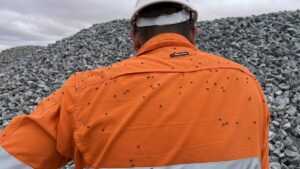Barry FitzGerald: Torque revs up gold exploration as left field merger delivers big gains

Sometimes, a gold merger is more than the sum of its parts. Pic: Supplied/Stockhead
“Garimpeiro” columnist Barry FitzGerald has covered the resources industry for 35 years. Now he’s sharing the benefits of his experience with Stockhead readers.
Back in late January a merger of equals announced between two $12 million junior explorers seemed a bit odd.
Torque Metals (ASX:TOR) was a WA gold explorer with 250,000oz of gold under its belt and Aston Minerals was very much focussed on its 1.5Moz gold project in Canada.
No synergies there with a geographical diversity unlikely to attract investors, or so it seemed in the first instance.
But how things have changed. The combined group – trading under the enlarged Torque banner – has emerged as one of the most successful gold explorers in 2025, with analysts tipping more to come.
The $24m combination on the announcement of the merger is now valued at $174m, with Torque shares rocketing from 5c at the time of the merger announcement to 32c in this week.
Everyone one has been a winner.
In hindsight
Looking back now, the merger between the pair was not as odd as it first seemed.
Torque had its exciting Paris gold project to the south of Kambalda but was running out of funds to maintain drilling momentum. Aston meanwhile had $5m in cash, a clapped out share price and a complete lack of investor interest in its Edleston gold (and nickel) project in Ontario.
More than that though has been the cross fertilisation of exploration knowledge which has powered up investor interest in the Paris project.
Aston was a Tolga Kumova/Evan Cranston company and they had been watching Torque’s progress at Paris.
Thanks to their involvement in Bellevue Gold (ASX:BGL) when it was an exploration success story on its way to establishing a high-grade 3.2Moz resource, they pinned Paris as a project that could also benefit from a down hole electromagnetic (DHEM) exploration strategy.
Bellevue employed DHEM to great effect. It’s a geophysical technique used to detect conductive materials from a down hole position.
It is particularly effective in identifying massive sulphide mineralisation where gold is associated with highly conductive sulphides (pyrrhotite, chalcopyrite) within fault-hosted veins.
Post the merger, Torque first confirmed that DHEM could work at Paris. Come May, it was able to report multiple DHEM conductor “plates” had been identified well beyond the boundaries of the current resource.
Then came the fun part of drilling the conductor plates. In a Eureka moment in July, Torque reported first assays from a targeted drilling program.
Thick and juicy hits were returned from the drilling from well outside of existing mineral resource estimate. One intersection of 16m at 7.95g/t gold from 272m, including 4.63m at 25.6g/t, was 240m west of the resource.
More recently, there has been more success with the DHEM technique. Torque MD Cristian Moreno commented on September 22 that the company would be accelerating the systematic testing of its growing network of conductors.
“These outcomes reinforce our strategy of integrating geology, structural analysis, geophysics and drilling to continue expanding the Paris deposit well beyond the current mineral resource estimate,” he said.
Standalone potential
The current mineral resource stands at 250,000oz at 3.1g/t. Given its location near a number of third party mills, Paris already has near-term development potential. But with DHEM unlocking a much bigger story, Paris now has both standalone and toll treatment potential.
It is an unfolding story to which Kumova and Cranston have ongoing exposure. The pair are listed as substantial shareholders of the enlarged Torque.
Where Paris and the untapped potential of Torque’s big ground position ends up remains to be seen. But the market is clearly keen on the story.
Evolution Capital initiated coverage of Torque when it was a 32.5c stock on September 4. It set a price target of $1.23.
“Paris is a scalable, high-grade gold system offering leveraged exposure to bullion. Tolling provides near-term optimality, while long-term value lies in a standalone mill, with a more than 1Moz resource potential as the key catalyst,” the broker said.
Evolution said that the DHEM technique was providing a low-risk, low-cost, physics-driven vector for resource growth.
The views, information, or opinions expressed in this article are solely those of the columnist and do not represent the views of Stockhead. Stockhead does not provide, endorse or otherwise assume responsibility for any financial product advice contained in this article.
Related Topics

UNLOCK INSIGHTS
Discover the untold stories of emerging ASX stocks.
Daily news and expert analysis, it's free to subscribe.
By proceeding, you confirm you understand that we handle personal information in accordance with our Privacy Policy.








